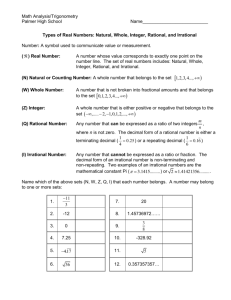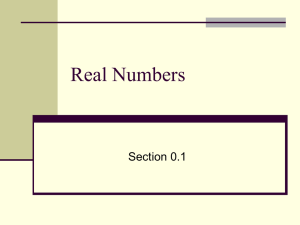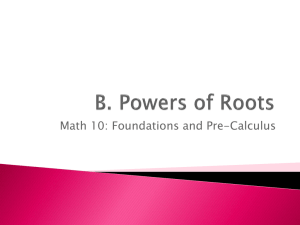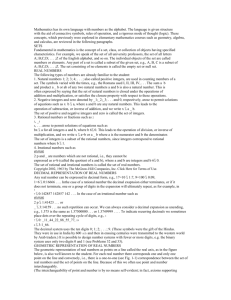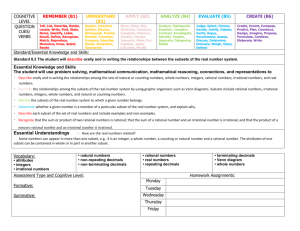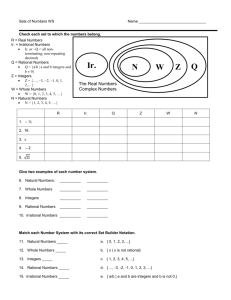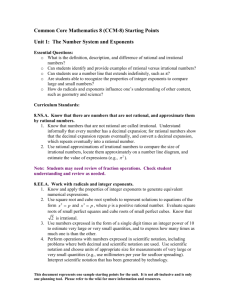HCPSS Curriculum Framework Grade 8 Unit 1
advertisement
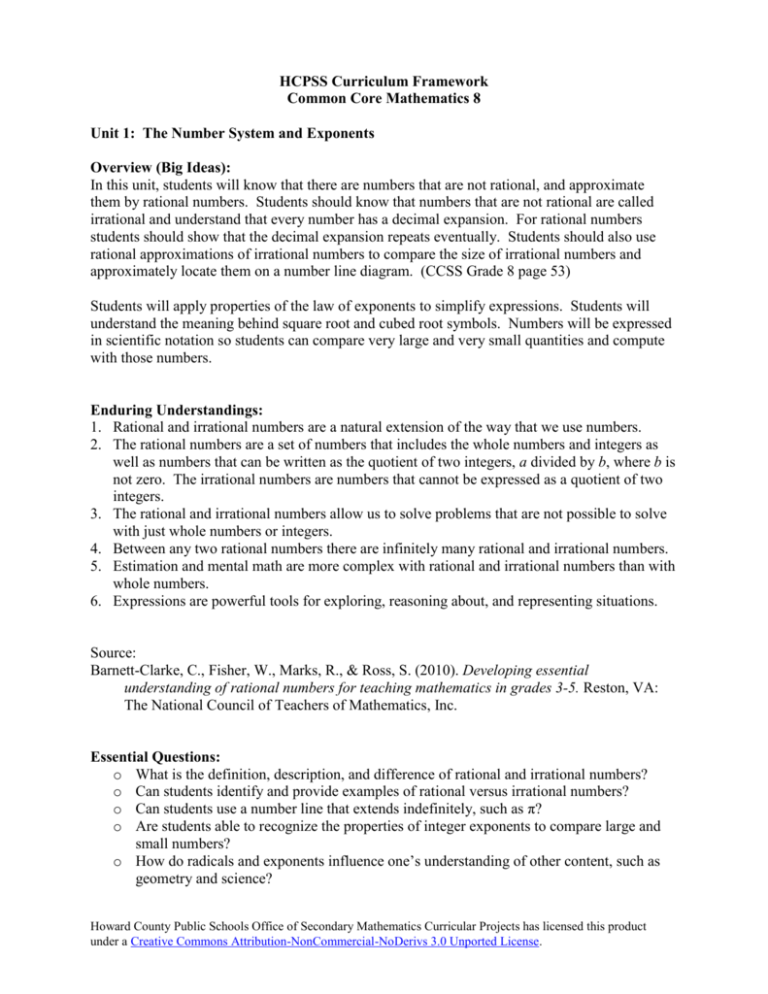
HCPSS Curriculum Framework Common Core Mathematics 8 Unit 1: The Number System and Exponents Overview (Big Ideas): In this unit, students will know that there are numbers that are not rational, and approximate them by rational numbers. Students should know that numbers that are not rational are called irrational and understand that every number has a decimal expansion. For rational numbers students should show that the decimal expansion repeats eventually. Students should also use rational approximations of irrational numbers to compare the size of irrational numbers and approximately locate them on a number line diagram. (CCSS Grade 8 page 53) Students will apply properties of the law of exponents to simplify expressions. Students will understand the meaning behind square root and cubed root symbols. Numbers will be expressed in scientific notation so students can compare very large and very small quantities and compute with those numbers. Enduring Understandings: 1. Rational and irrational numbers are a natural extension of the way that we use numbers. 2. The rational numbers are a set of numbers that includes the whole numbers and integers as well as numbers that can be written as the quotient of two integers, a divided by b, where b is not zero. The irrational numbers are numbers that cannot be expressed as a quotient of two integers. 3. The rational and irrational numbers allow us to solve problems that are not possible to solve with just whole numbers or integers. 4. Between any two rational numbers there are infinitely many rational and irrational numbers. 5. Estimation and mental math are more complex with rational and irrational numbers than with whole numbers. 6. Expressions are powerful tools for exploring, reasoning about, and representing situations. Source: Barnett-Clarke, C., Fisher, W., Marks, R., & Ross, S. (2010). Developing essential understanding of rational numbers for teaching mathematics in grades 3-5. Reston, VA: The National Council of Teachers of Mathematics, Inc. Essential Questions: o What is the definition, description, and difference of rational and irrational numbers? o Can students identify and provide examples of rational versus irrational numbers? o Can students use a number line that extends indefinitely, such as π? o Are students able to recognize the properties of integer exponents to compare large and small numbers? o How do radicals and exponents influence one’s understanding of other content, such as geometry and science? Howard County Public Schools Office of Secondary Mathematics Curricular Projects has licensed this product under a Creative Commons Attribution-NonCommercial-NoDerivs 3.0 Unported License. Curriculum Standards: 8.NS.A Know that there are numbers that are not rational, and approximate them by rational numbers. 1. Know that numbers that are not rational are called irrational. Understand informally that every number has a decimal expansion; for rational numbers show that the decimal expansion repeats eventually, and convert a decimal expansion which repeats eventually into a rational number. 2. Use rational approximations of irrational numbers to compare the size of irrational numbers, locate them approximately on a number line diagram, and estimate the value of expressions (e.g., 2 ). For example, by truncating the decimal expansion of 2 , show that 2 is between 1 and 2, then between 1.4 and1.5, and explain how to continue on to get better approximations. 8.EE.A Work with radicals and integer exponents. 1. Know and apply the properties of integer exponents to generate equivalent numerical expressions. For example, 32 35 33 1 / 33 1 / 27 . 2. Use square root and cube root symbols to represent solutions to equations of the form x 2 p and x 3 p , where p is a positive rational number. Evaluate square roots of small perfect squares and cube roots of small perfect cubes. Know that 2 is irrational. 3. Use numbers expressed in the form of a single digit times an integer power of 10 to estimate very large or very small quantities, and to express how many times as much one is than the other. For example, estimate the population of the United States as 3 10 8 and the population of the world as 7 109 , and determine the world population is more than 20 times larger. 4. Perform operations with numbers expressed in scientific notation, including problems where both decimal and scientific notation are used. Use scientific notation and choose units of appropriate size for measurements of very large or very small quantities (e.g., use millimeters per year for seafloor spreading). Interpret scientific notation that has been generated by technology. Common Misconceptions: o Students may see irrational numbers as truncated because of the use of the calculator; for example π equaling 3.14. o Students may confuse the radical sign with the division sign. o Students may think that the number line only has the numbers that are labeled. o Often students might misunderstand the relative size of numbers. o Students may confuse the operations for the properties of integer exponents. There is a tendency to memorize rules rather than internalize the concepts behind the laws of exponents. o Students struggle with the appropriate application of exponents to coefficients. o Students may incorrectly assume that the value of a number is negative when its exponent is negative. o Students often confuse power of a power and product of powers. Howard County Public Schools Office of Secondary Mathematics Curricular Projects has licensed this product under a Creative Commons Attribution-NonCommercial-NoDerivs 3.0 Unported License. o o o o o As a result of weaknesses with fractions, students struggle with the simplification of negative exponents. Many students do not fully grasp that division is defined as multiplication by a reciprocal. As a result, students memorize rules for negative exponents without conceptualizing the reason behind the rules. When simplifying using the quotient of powers rule, subtraction mistakes are often made. Students may forget that each rational number has a negative square root, as well as a principal (positive) square root. Students may easily confuse the radical symbol with the long division symbol. Students may miscount the decimal places for a value in decimal notation when expressing the same value in scientific notation. Howard County Public Schools Office of Secondary Mathematics Curricular Projects has licensed this product under a Creative Commons Attribution-NonCommercial-NoDerivs 3.0 Unported License.



